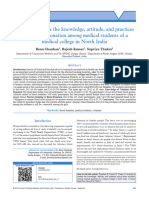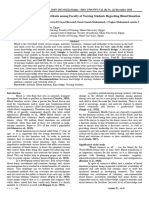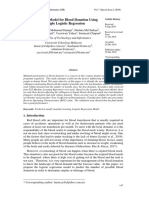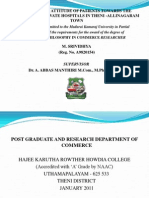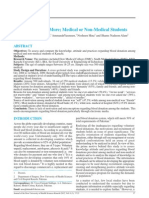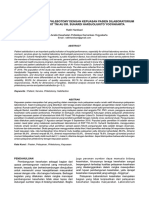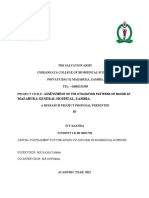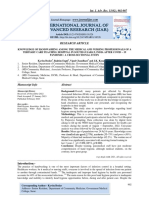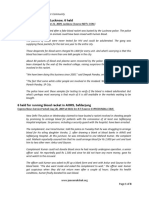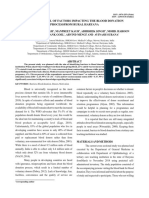Professional Documents
Culture Documents
Assessment of Awareness Regarding Blood Donation Among Hospital Support Staff in Selected Hospitals, Shillong, Meghalaya
Copyright
Available Formats
Share this document
Did you find this document useful?
Is this content inappropriate?
Report this DocumentCopyright:
Available Formats
Assessment of Awareness Regarding Blood Donation Among Hospital Support Staff in Selected Hospitals, Shillong, Meghalaya
Copyright:
Available Formats
Volume 11, Issue 3, March 2023 International Journal of Innovative Science and Research Technology
ISSN No:-2456-2165
Assessment of Awareness Regarding Blood Donation
among Hospital Support Staff in Selected Hospitals,
Shillong, Meghalaya
Indrani Devi Nath 1, Aibrihun Kharsahnoh2, Hospi Langshiang3, Manasseh Teron4, Neha Sharma5, Misso Sunya6, Hima Das7
1-6
B. Sc. Nursing students, College of Nursing,
7
Tutor/Clinical Instructor, College of Nursing.
North Eastern Indira Gandhi Regional Institute of Health and Medical Science (NEIGRIHMS),
Shillong, Meghalaya, India, Pincode- 793018
Corresponding Author: Indrani Devi Nath
Abstract:- Blood transfusions save lives in various life I. INTRODUCTION
threatening conditions. Safe blood is one of the critical
components in improving health care and in preventing A. Background Of The Study
the spread of infectious diseases globally. In Meghalaya, A single pint of donated blood can save up to three lives;
voluntary donations constitute only one third of all blood however, because of its limited shelf life, there is a need for
donations and majority of blood donations is from constant blood donation1. According to National AIDS
replacement donors. Control Organization, an ideal health care system should
address 100% demand for blood by ensuring uninterrupted
A cross-sectional study was conducted to assess the supply. However, according to current estimates of
awareness regarding blood donation among hospital Meghalaya, only 38.3% of this blood is from voluntary
support staff in selected hospitals, Shillong, Meghalaya blood donation. The gap between clinical demand and
by using self-administered questionnaire among 138 supply is large due to the low volume of voluntary blood
participants using consecutive sampling technique. donation, lack of awareness, irrational demand, poor supply
Findings of the study showed that out of 138 chain management system etc[2,3].
participants, maximum i.e., 98 (71.01%) participants
have average knowledge regarding blood donation and According to a study conducted by Ministry of health
majority i.e., 136(98.60%) had favourable attitude and family welfare and National AIDS Control Organization
towards blood donation. However, only 49(35.51%) out of India in 2018, the quantum of blood to cater to the
of 138 participants had previous history of blood medical needs was estimated at 10.6 million units. This
donation, 89 (64.49%) had no previous history of blood implies that the country needs to collect 10.6 million whole
donation and the reason stated for not donating blood by blood to meet the need for whole blood and components in
maximum participants i.e. 29(32.58%) was “Never the country[4,5]. According to available estimates, 25% of all
approached by anyone to donate blood”. The findings Maternal deaths are due to hemorrhage6. Reports indicate
also revealed that majority of the participants that 70% of the PPH related deaths are due to lack of
i.e.,76(55.10%) had received information regarding immediate availability of blood7. Uncontrolled bleeding
blood donation from “Health professionals”. accounts for more than 468,000 deaths per year8. A study
conducted in a tertiary care hospital, Chitradurga in 2018,
The recommendations of the study is that, a states that even though the hospital workers are aware about
planned awareness program can be conducted for the blood donation, many of them were never voluntary blood
hospital support staff regarding the importance of donors9.
voluntary blood donation where the health professionals
can also approach hospital support staffs to motivate B. Need For The Study
them to donate blood to facilitate the practice of Hospitals are mainly dependent on patient’s relatives to
voluntary blood donation among them to save lives. replace the necessary blood as there are not enough
voluntary blood donations to help the needy patients.
Keywords:- Assessment, Awareness regarding Blood Maximum blood donations in our blood banks is on
Donation, Hospital support staff. replacement basis. The patient’s relatives are now urged to
find eligible blood donors to replace the blood used for the
patients, which will not be always available.
IJISRT23MAR830 www.ijisrt.com 999
Volume 11, Issue 3, March 2023 International Journal of Innovative Science and Research Technology
ISSN No:-2456-2165
Eligible health care support staff can be a very reliable was conducted among Hospital Support Staff at
and accessible source of quality blood if they are motivated NEIGRIHMS, Shillong, Meghalaya.
and are willing to be voluntary blood donors. In case of
emergencies, blood donated by these Support staff can save D. STUDY POPULATION:
lives and regular donation of blood by them can increase the The population comprised of Hospital Support Staff
availability of blood. These staff could also inculcate the working in Civil hospital, Shillong and North Eastern Indira
messages of blood donation to other staffs they meet in their Gandhi Regional Institute of Health and Medical Sciences,
routine work and recruit more donors to increase the total Shillong.
blood collection.
E. SAMPLE SIZE:
Thus, this study is primarily designed to assess the The sample size calculation for the pilot study was 38
awareness regarding blood donation among hospital support and for the final study was 138.
staffs. Though studies regarding blood donation awareness
is conducted at international and national level among F. SAMPLE TECHNIQUE:
medical professionals, studies are limited among hospital In our study, sampling technique used is consecutive
support staff. This study will provide information about sampling technique.
awareness level regarding blood donation among the G. DATA COLLECTION PROCEDURE:
hospital support staff which may be helpful in planning need The final data collection was done from 23rd May to 3rd
based awareness program. June 2022. Permission was obtained from the Directorate of
C. Objectives of the Study health services, Meghalaya and the Medical Superintendent,
NEIGRIHIMS, Shillong, Meghalaya. After obtaining
Primary objective: permission, the study was conducted. Prior to the data
To assess the knowledge regarding blood donation collection, informed consent was taken from the participants
among Hospital Support Staff in selected hospitals, to explain the procedure and the purpose of the study, which
Shillong, Meghalaya. also stated the confidentiality and anonymity of the results.
To assess the attitude regarding blood donation among Thereafter, the participants were allowed to proceed with the
Hospital Support Staff in selected hospitals, Shillong, self-administered questionnaire and the participants took
Meghalaya. approximately 10-15 minutes to complete it.
Secondary objective: H. SCORING OF THE TOOL:
To find out the association of knowledge with selected SECTION I: It consists of socio-demographic
socio-demographic variables regarding blood donation characteristics and was not scored.
among Hospital Support Staff in selected hospitals, SECTION II: It consists of 20 knowledge based
Shillong, Meghalaya. questionnaire to assess the level of awareness regarding
blood donation, in such a way that for each correct
D. Operational Definition response 1 mark is given. There is no negative marking
Assessment: It refers to the evaluation and estimation of given for a negative response. The maximum score is 20
the knowledge and attitude of hospital support staff and the minimum score is 0.
regarding blood donation. SECTION III: It consists of 10 attitude based statement
Awareness regarding blood donation: It refers to on a five-point Likert scale. The maximum score is 50
general understanding of hospital support staff on blood and the minimum score is 10.
donation.
Hospital support staff: For this study, hospital support I. INTERPRETATION OF SCORE:
staff refers to technicians, technical assistants, OT Knowledge score was categorized into three categories:
assistants, security personals and ward attendants in
CATEGORY Range of score Percentage
selected hospitals.
Good knowledge ≥16 ≥ 76%
II. METHODOLOGY Average knowledge 10-15 50 % - 75 %
Poor knowledge ≤9 ≤49%
A. RESEARCH APPROACH:
In this study, a quantitative research approach was Attitude score was categorized into two categories:
finalized to assess the awareness regarding blood donation
among hospital support staff. CATEGORY Range of score
Favorable Attitude >30
B. RESEARCH DESIGN: Unfavorable Attitude ≤30
In our study, the research design used is non-
experimental cross-sectional study design.
C. STUDY SETTINGS:
The pilot study was conducted among Hospital Support
Staff at Civil hospital, Shillong, Meghalaya. The final study
IJISRT23MAR830 www.ijisrt.com 1000
Volume 11, Issue 3, March 2023 International Journal of Innovative Science and Research Technology
ISSN No:-2456-2165
III. ANALYSIS, INTERPRETATION AND Data are presented under the following headings:
DISCUSSION Section 1: Findings related to the socio-demographic
data of the participants.
The data collected from the participants were analyzed Section 2: Findings related to the awareness of the
by using descriptive statistics (frequency, statistics) and participants regarding blood donation.
inferential statistics (Fisher’s exact test). The data are Section 3: Findings related to association of awareness
presented in the form of tables and bar diagram as illustrated regarding blood donation with selected socio-
below. demographic variables of the participants.
A. ORGANIZATION OF THE FINDINGS:
SECTION 1: FINDINGS RELATED TO THE SOCIO-DEMOGRAPHIC DATA OF THE PARTICIPANTS
N=138
80 73 (52.86%)
Number of participants
70 19- 32
60 53 (38.40%) 33- 46
50
47-60
40
30
20 12 (8.64%)
10
0
19- 32 33- 46 47-60
Age (in years)
Fig. 1: Bar graph showing the distribution of the participants according to age.
The data represented in figure 1 shows that out of 138 participants, maximum participants i.e., 73 (52.86%) participants
belong to the age group of 19-32 and minimum i.e., 12 (8.64%) participants belong to the age group of 47-60.
N=138
90 83(60.14%)
80
Number of participants
70
60 55(39.86%)
50
40 Male
30 Female
20
10
0
Male Female
Gender
Fig. 2: Bar graph showing the distribution of the participants according to gender
The data represented in figure 2 shows that out of 138 participants, maximum participants i.e., 83 (60.14%) participants are
male and 55 (39.86%) are female.
IJISRT23MAR830 www.ijisrt.com 1001
Volume 11, Issue 3, March 2023 International Journal of Innovative Science and Research Technology
ISSN No:-2456-2165
N=138
50
45(32.6%) Ward attendants
45
Security personnel
40 Technicians
37(26.8%)
35 Technical assistants
Number of participants
30(21.7%) OT assistants
30
25
20
15(10.8%)
15
11(7.9%)
10
0
Ward Security Technicians Technical OT assistants
attendants personnel assistants
Occupation
Fig. 3: Bar graph showing the distribution of the participants according to occupation
The data represented in figure 3 shows that out of 138 participants, maximum i.e., 45 (32.6%) participants are ward
attendants, and minimum i.e.,11 participants (7.9%) are OT assistants.
N=138
Ethnicity Frequency (f) Percentage (%)
Khasi 115 83.3 %
Assamese 9 6.5 %
Bengali 4 2.9 %
Mizo 3 2.2 %
Bihari 3 2.2 %
Keralites 2 1.5 %
Manipuri 1 0.7 %
Rajasthani 1 0.7 %
Table 1: Frequency and percentage distribution of the participants according to ethnicity
The data represented in table 1 shows that out of 138 participants, majority i.e., 115 (83.3%) participants are Khasi and
minimum i.e., 1 (0.7%) participant is manipuri and 1(0.7%) participant is Rajasthani.
n=89
IJISRT23MAR830 www.ijisrt.com 1002
Volume 11, Issue 3, March 2023 International Journal of Innovative Science and Research Technology
ISSN No:-2456-2165
100 N=138
89 (64.5%)
90 No
Number of participants 80 Yes
70
60
49 (35.5%)
50
40
30
20
10
0
No Yes
Previous history of blood donation
Fig. 4: Bar diagram showing distribution of the participants according to previous history of blood donation
The data represented in figure 4 shows that out of 138 previous history of blood donation and 49 (35.5%) have
participants, majority89 (64.5%) participants have no donated blood before.
Reason Frequency (f) Percentage (%)
Never approached by anyone to donate blood 29 32.58%
Due to health related reasons 24 26.97%
Never had the time or opportunity to donate blood 16 17.98%
Underweight 15 16.85%
Do not know the place to donate 5 5.62%
Table 2: Frequency and percentage distribution of the participants according to reason for not donating blood
The data represented in Table 2 shows that out of 89 approached by anyone to donate blood and minimum i.e.,
participants who had no previous history of blood donation, 5(5.62%) participants did not know the place to donate
maximum i.e., 29 (32.58%) participants were never blood.
N=138
Source of information Frequency (f) Percentage (%)
Health Professionals 76 55.1%
Friends and family 43 31.2%
Internet 12 8.7%
Television 6 4.3%
Newspaper 1 0.7%
Table 3: Frequency and percentage distribution of the participants according to their source of information regarding blood
donation
The data represented in Table 3 shows that out of 138 minimum i.e. 1(0.7%) participants have received the
participants, maximum i.e. 76(55.1%) participants have information regarding blood donation from newspaper.
received information from health professionals and
IJISRT23MAR830 www.ijisrt.com 1003
Volume 11, Issue 3, March 2023 International Journal of Innovative Science and Research Technology
ISSN No:-2456-2165
SECTION 2: FINDINGS RELATED TO THE AWARENESS OF THE PARTICIPANTS REGARDING BLOOD
DONATION.
N=138
120
98 (71.01%)
100
80
Number of participants
60 Good
40 25 (18.12%) Average
20 15 (10.87%) Poor
0
Good Average Poor
Level of knowledge
Fig. 5: Bar diagram showing distribution of the participants according to their level of knowledge regarding blood donation
The data represented in figure 5 shows that out of 138 participants have good knowledge and minimum i.e., 15
participants, maximum i.e., 98 (71.01%) participants have (10.87%) participants have poor knowledge regarding blood
average knowledge regarding blood donation, 25 (18.12%) donation.
N=138
160
Number of participants
136(98.6%)
140
120
100
80
Favorable
60
Unfavorable
40
20 2(1.4%)
0
Favorable Unfavorable
Attitude
Fig. 6: Bar diagram showing distribution of the participants according to their type of attitude regarding blood donation
The data represented in figure 6 shows that out of (1.4%) participants have unfavourable attitude towards
138participants, maximum i.e., 136 (98.6%) participants blood donation.
have favourable attitude towards blood donation and only 2
N=138
Variable Mean SD
Knowledge 12.84 2.76
Table 4: Mean and standard deviation of knowledge score of participants regarding blood donation
Maximum possible score: 20
Data in Table 4 shows that mean awareness score is 15 which signifies that majority of the subjects were having
12.84 which is more than 50% of maximum possible score average knowledge regarding blood donation.
i.e., 10 and less than 75% of maximum possible score i.e.,
IJISRT23MAR830 www.ijisrt.com 1004
Volume 11, Issue 3, March 2023 International Journal of Innovative Science and Research Technology
ISSN No:-2456-2165
SECTION 3: FINDINGS RELATED TO ASSOCIATION OF AWARENESS REGARDING BLOOD DONATION
WITH SELECTED SOCIO-DEMOGRAPHIC VARIABLES OF THE PARTICIPANTS.
N=138
Demographic v Awareness Score Fisher’s exact tes P value/ exact s Tabulated
ariables t value ignificance value
Gender Good Average Poor
Male 12 64 7
Female 13 34 8 3.76 0.152 1.36
Table 5: Association of knowledge regarding blood donation with the gender of the participants
* p-value< 0.05
The data in Table 5 shows that the calculated value not significantly associated with gender. Therefore, the
i.e.,3.76 is more than the tabulated value i.e., 1.36. researcher concludes that awareness of the participants
Moreover, the exact significance is 0.152 which is greater regarding blood donation among Hospital Support Staff is
than p-value (<0.05). So, knowledge of the participants is not dependent on gender of the participants.
N=138
Demographic variables Awareness Score Fisher’s exact t P value/ exact s Tabulated v
est value ignificance alue
Previous history of Good Average Poor
blood donation
Yes
12 35 7
No
13 63 8 4.93 0.085 2.10
Table 6: Association of knowledge regarding blood donation with the previous history of blood donation of the participants
* p-value< 0.05
The data in Table 6 shows that the calculated value V. CONCLUSION
i.e.,4.93 is more than the tabulated value i.e., 2.10.
Moreover, the exact significance is 0.085 which is greater Findings of the study revealed that majority of the
than p-value (<0.05). So, knowledge of the participants is hospital support staff have average knowledge and
not significantly associated with previous history of blood favourable attitude towards blood donation. The most
donation. Therefore, the researcher concludes that common reason for not donating blood was “Never
awareness of the participants regarding blood donation approached by anyone”. In addition, “Health professionals”
among Hospital Support Staff is not dependent on previous was the major source of information regarding blood
history of blood donation. donation.
IV. DISCUSSION REFERENCES
The study revealed that out of 89 participants who had [1.] Agarwal N, Pandey P, Kumar P. Promotion of
no previous history of blood donation, the reason stated for voluntary blood donation among hospital
not donating blood by majority i.e., 29(32.58%) of the employees. Journal of Family and Community
participants was “Never approached by anyone to donate Medicine. 2016 Sep 1;23(3):184.
blood”. A similar study conducted by DanielM.J., Prakash [2.] Siromani U, TsubakiT,Daniel D, Mammen J, Nair
H.M., Dhivya K.,et al, (2014) in Tamil Nadu revealed that S. A perspective study on the attitude to and
among 470 participants who had never donated blood practice of voluntary blood donation in a tertiary
before, the major reason for not donating blood among them referral hospital in South India. African Journal of
was that they were “Never asked to donate blood” Medical and Health Sciences. 2014 Jul 1;13(2):85.
[3.] National AIDS Control Organisation (NACO).
Assessment and Estimation of Blood Banks and
Blood Requirements in Meghalaya, India. Ministry
of health and family welfare. 2018.
IJISRT23MAR830 www.ijisrt.com 1005
Volume 11, Issue 3, March 2023 International Journal of Innovative Science and Research Technology
ISSN No:-2456-2165
[4.] Dal Poz MR, Kinfu Y, Dräger S, Kunjumen T. [16.] Dubey A, Sonker A, Chaurasia R, Chaudhary R.
Counting health workers: definitions, data, Knowledge, attitude and beliefs of people in North
methods and global results. World Health India regarding blood donation. Blood Transfusion.
Organization. 2007 Jan. 2014.
[5.] National AIDS Control Organisation (NACO). [17.] Mullah F, Kumar D, Antani D, Gupta M. Study of
National Estimation of Blood Requirement in knowledge, perceptions and practices related to
India. New Delhi. Ministry of health and family blood donation among the healthcare support staff
welfare. 2018. of a tertiary care hospital in Gujarat, India. Online
[6.] BK Murthy, MB Murthy, PM Prabhu. International Journal of Health and Allied Sciences. 2013 Apr
journal of preventive medicine 4(1), 105, 2013. 15;12(1 (2)).
[7.] Yadav, K., Namdeo, A., & Bhargava, M. (2013). A [18.] Dhara A, Dinesh K. A Qualitative study of
retrospective and prospective study of maternal perceptions about voluntary blood donation among
mortality in a rural tertiary care hospital of central the supportive service of a multispecialtity rural
India. Indian Journal of Community Health, 25(1), tertiary care hospital. 2012
16-21. [19.] Daniel MJ, Prakash HM, Dhivya K, Kumar SA,
[8.] World Health Organiation. More voluntary blood Arun R, Subash S, Krishnamoorthy R. Opinions
donations essential. Geneva: World Health about Blood Donation amongst Medical
Organization. 2012. [Cited 2013 May 20]. Personnel's. Journal of Clinical and Diagnostic
[9.] Sameeya FS, Reddy MR. Factors Influencing Research. 2014 Jan 12;8(1):43-5.
blood donation among the workers of a Tertiary [20.] Accreditation Standards on Blood Banks/ Blood
care hospital, Chitradurga: a comparative study. Int centres and Transfusion Services. National
J Community Med Public Health 2018;5:1004-9. accreditation board for Hospital and Health Care
[10.] Mitra K, Mandal PK, Nandy S, Roy R, Joardar Providers. Quality Council of India, 3rd ed. 2016.
GK, Mishra R. A Study on Awareness and [21.] Suresh S. Nursing Research and Statistics. Elsevier
Perceptions Regarding Blood Safety and Blood Health Sciences; 2018 June.
Donation among Health Care Providers in a
Teaching Hospital of Calcutta. Indian J
Community Med 2001;26:21-21.
[11.] Teferi MY, Woldesenbet SG, Feleke SA, Abebe
EH, Adane HT, Alemayehu CM. Assessment of
the level and factors associated with knowledge,
attitude and practice of blood donation among
medical and paramedical personnel in ALERT
Hospital, Ethiopia. Journal of Public Health
Research. 2021 Jan 14;10(1).
[12.] Tadesse T, Berhane T, Abraha TH, Gidey B,
Hagos E, Grum T, Gerensea H. Blood donation
practice and associated factors among health
professionals in Tigray regional state public
hospitals, northern Ethiopia. BMC research notes.
2018 Dec;11(1):1-6.
[13.] Arage G, Ibrahim S, Adimasu E. Blood donation
practice and its associated factors among health
professionals of University of Gondar Hospital,
Northwest Ethiopia: a cross sectional study. BMC
research notes. 2017 Dec;10(1):1-6.
[14.] Nwogoh B, Aigberadion U, Nwannadi AI.
Knowledge, attitude, and practice of voluntary
blood donation among healthcare workers at the
University of Benin Teaching Hospital, Benin City,
Nigeria. Journal of blood transfusion. 2013;2013.
[15.] S., SameeyaFurmeen; REDDY, Mayuri Reddy.
Factors influencing blood donation among the
workers of a tertiary care hospital, Chitradurga: a
comparative study. International Journal Of
Community Medicine And Public Health. Feb
2018. 5, 1004-1009. ISSN 2394-6040.
IJISRT23MAR830 www.ijisrt.com 1006
You might also like
- Introduction To Microelectronic Fabrication PDFDocument332 pagesIntroduction To Microelectronic Fabrication PDFChristy Moore92% (13)
- Grua Grove 530e 2 Manual de PartesDocument713 pagesGrua Grove 530e 2 Manual de PartesGustavo100% (7)
- Rajiv Gandhi University of Health Sciences Bangalore, KarnatakaDocument15 pagesRajiv Gandhi University of Health Sciences Bangalore, KarnatakaPradip ChougaleNo ratings yet
- Ferrero A.M. Et Al. (2015) - Experimental Tests For The Application of An Analytical Model For Flexible Debris Flow Barrier Design PDFDocument10 pagesFerrero A.M. Et Al. (2015) - Experimental Tests For The Application of An Analytical Model For Flexible Debris Flow Barrier Design PDFEnrico MassaNo ratings yet
- A Study To Assess The Knowledge, Attitude, and Practices About Blood Donation Among Medical Students of A Medical College in North IndiaDocument5 pagesA Study To Assess The Knowledge, Attitude, and Practices About Blood Donation Among Medical Students of A Medical College in North IndiabigxNo ratings yet
- File by AkshuDocument52 pagesFile by AkshuAkshay DagarNo ratings yet
- Knowledge, Attitude and Practice Regarding Blood Donation in Medical Undergraduates: A Cross Sectional StudyDocument5 pagesKnowledge, Attitude and Practice Regarding Blood Donation in Medical Undergraduates: A Cross Sectional StudydeebahashNo ratings yet
- Ethics of Blood TransfusionDocument6 pagesEthics of Blood TransfusionHo Yong WaiNo ratings yet
- Inter-Rater Reliability Assessment For Motivating Factors in Blood Donation Using Cohen's Kappa AnalysisDocument10 pagesInter-Rater Reliability Assessment For Motivating Factors in Blood Donation Using Cohen's Kappa AnalysisNURHAFIZAH BINTI ABDUL MUSIDNo ratings yet
- Faculty of Nursing Students Regarding Blood DonationDocument9 pagesFaculty of Nursing Students Regarding Blood DonationbigxNo ratings yet
- Knowledge and Attitude Regarding Blood Donation in Rural Puducherry, IndiaDocument5 pagesKnowledge and Attitude Regarding Blood Donation in Rural Puducherry, IndiaCahya Maha RaniNo ratings yet
- Knowledge Attitude and Practice On VolunDocument6 pagesKnowledge Attitude and Practice On VolunCerastes CerastesNo ratings yet
- 01 09+Hubungan+Antara+Pengetahuan+Dengan+Minat+Mendonorkan+Darah+Di+Masa+Pandemi+CovidDocument9 pages01 09+Hubungan+Antara+Pengetahuan+Dengan+Minat+Mendonorkan+Darah+Di+Masa+Pandemi+CovidRosyasya SalsabilaNo ratings yet
- Factors Affecting Blood Donation Among Lapsed and Prospective Blood Donors in Manila, PhilippinesDocument6 pagesFactors Affecting Blood Donation Among Lapsed and Prospective Blood Donors in Manila, PhilippinesjubainuNo ratings yet
- Satisfaction Level of Patients Visiting Outpatient Department in A Tertiary Care Hospital of Delhi - A Cross-Sectional StudyDocument6 pagesSatisfaction Level of Patients Visiting Outpatient Department in A Tertiary Care Hospital of Delhi - A Cross-Sectional StudyAdvanced Research PublicationsNo ratings yet
- Suab 047Document4 pagesSuab 047Anonymous oQtve4oNo ratings yet
- Pages From GMP001 - Module01 - Course04Document10 pagesPages From GMP001 - Module01 - Course04Mangesh RautNo ratings yet
- Research Proposal Form: Review Board/ Ethical CommitteeDocument9 pagesResearch Proposal Form: Review Board/ Ethical CommitteeShahzeb KhanNo ratings yet
- Contributing Factors To Hemodialysis Adherence in Aceh, Indonesia - ScienceDirectDocument6 pagesContributing Factors To Hemodialysis Adherence in Aceh, Indonesia - ScienceDirectlaamaghfirohNo ratings yet
- Ojsadmin, 109Document6 pagesOjsadmin, 109Kemo JakNo ratings yet
- An Assessment of Patients Satisfaction With ServicDocument14 pagesAn Assessment of Patients Satisfaction With Servicsubhan takildarNo ratings yet
- Crossmatch Transfusion Ratio As Indicators Blood Service QualityDocument6 pagesCrossmatch Transfusion Ratio As Indicators Blood Service QualityAnonymous izrFWiQNo ratings yet
- Research Proposal Form: Review Board/ Ethical CommitteeDocument9 pagesResearch Proposal Form: Review Board/ Ethical CommitteeShahzeb KhanNo ratings yet
- Azad Kashmir (2020)Document7 pagesAzad Kashmir (2020)Joseph Carrera DelgadoNo ratings yet
- IJCRT2105420Document8 pagesIJCRT2105420sneha latha reddyNo ratings yet
- Why Some Donors Are More Willing To Donate Platelets? - A Qualitative Study On 25 Regular Platelet Donors in Guangzhou, ChinaDocument8 pagesWhy Some Donors Are More Willing To Donate Platelets? - A Qualitative Study On 25 Regular Platelet Donors in Guangzhou, Chinaminimus mimiNo ratings yet
- 14 - 3715Document3 pages14 - 3715scribdnotes123No ratings yet
- A Prediction Model For Blood Donation Using Multiple Logistic RegressionDocument11 pagesA Prediction Model For Blood Donation Using Multiple Logistic Regressionhusain albaqaliNo ratings yet
- Opinion and Attitude of Patients Towards The Services of Private Hospitals in Theni - Allinagaram TownDocument18 pagesOpinion and Attitude of Patients Towards The Services of Private Hospitals in Theni - Allinagaram TownVino KannanNo ratings yet
- Blood LineDocument8 pagesBlood LineSam Chandran CNo ratings yet
- Supplement 13Document7 pagesSupplement 13Rizki Bagus MaulanaNo ratings yet
- Short ReportDocument2 pagesShort Reportscribdnotes123No ratings yet
- Zahid RevisedDocument7 pagesZahid Revisedrokeya tamannaNo ratings yet
- Organ Donation ArticleDocument11 pagesOrgan Donation ArticlenaderbokhariNo ratings yet
- A Study of Patient Satisfaction Level in Out Patient Department (OPD) in A Tertiary Care Hospital in MaharashtraDocument9 pagesA Study of Patient Satisfaction Level in Out Patient Department (OPD) in A Tertiary Care Hospital in MaharashtraVital TejaNo ratings yet
- Study of The Ratio of Cross-Matching To Transfusio PDFDocument7 pagesStudy of The Ratio of Cross-Matching To Transfusio PDFampratikna 14No ratings yet
- 5-Who Donates MoreDocument5 pages5-Who Donates Morescribdnotes123No ratings yet
- Blood Donor's Preferences Toward Incentives For Donation in ChinaDocument12 pagesBlood Donor's Preferences Toward Incentives For Donation in ChinaSabrina NMNo ratings yet
- Hubungan Pelayanan Phlebotomy Dengan Kepuasan Pasien Dilaboratorium Klinik Rumah Sakit Tni Au Dr. Suhardi Hardjolukito YogyakartaDocument8 pagesHubungan Pelayanan Phlebotomy Dengan Kepuasan Pasien Dilaboratorium Klinik Rumah Sakit Tni Au Dr. Suhardi Hardjolukito YogyakartaKesatria Bayu KencanaNo ratings yet
- Ijgm 7 401Document10 pagesIjgm 7 401Dewi NurramdhaniNo ratings yet
- Social Project ReportDocument34 pagesSocial Project ReportRushikesh DahiphaleNo ratings yet
- Voluntary Non-Remunerated Blood Donations To Ensure Blood Safety in The WHO South-East AsiaDocument26 pagesVoluntary Non-Remunerated Blood Donations To Ensure Blood Safety in The WHO South-East AsiaOverride YouNo ratings yet
- MRF 12Document17 pagesMRF 12Carolina UrrutiaNo ratings yet
- 1 s2.0 S0041134517303378 MainDocument6 pages1 s2.0 S0041134517303378 MainZHANGQYNo ratings yet
- The Analysis of The Rural Outreach Programme of ADocument8 pagesThe Analysis of The Rural Outreach Programme of AKusum GuptaNo ratings yet
- Assessment of Knowledge and Attitude Towards Blood DonationDocument17 pagesAssessment of Knowledge and Attitude Towards Blood DonationbigxNo ratings yet
- Smart Blood FinderDocument6 pagesSmart Blood FinderEditor IJTSRDNo ratings yet
- My CDPDocument28 pagesMy CDPKotha surya varshithNo ratings yet
- Assessment of The Utilization Patterns of Blood AT Mazabuka General Hospital, ZambiaDocument11 pagesAssessment of The Utilization Patterns of Blood AT Mazabuka General Hospital, ZambiaMukale Chipego MoongaNo ratings yet
- Assessment of The Utilization Patterns of Blood AT Mazabuka General Hospital, ZambiaDocument11 pagesAssessment of The Utilization Patterns of Blood AT Mazabuka General Hospital, ZambiaMukale Chipego MoongaNo ratings yet
- Awarenessof Blood Donation Amongthe Nursing SatffDocument8 pagesAwarenessof Blood Donation Amongthe Nursing SatffSri Intan KhairunnisaNo ratings yet
- Chapter 1 IntroductionDocument5 pagesChapter 1 Introductionsuper star videos SPsNo ratings yet
- Hhs Public Access: Protocolized Fluid Therapy in Brain-Dead Donors: The Multi-Center Randomized Monitor TrialDocument17 pagesHhs Public Access: Protocolized Fluid Therapy in Brain-Dead Donors: The Multi-Center Randomized Monitor TrialAndrea GuerreroNo ratings yet
- Journal Homepage: - : IntroductionDocument6 pagesJournal Homepage: - : IntroductionIJAR JOURNALNo ratings yet
- 13-2 Collated 3 (3) - 149-155Document7 pages13-2 Collated 3 (3) - 149-155Inas AzharNo ratings yet
- Blood Racket Busted in Lucknow, 6 Held: Presented By: Jitendra Kumar Jeevanrakshak, The Lifesaver CommunityDocument8 pagesBlood Racket Busted in Lucknow, 6 Held: Presented By: Jitendra Kumar Jeevanrakshak, The Lifesaver CommunitypulsarknowledgeNo ratings yet
- CD4CD8 Lymphocyte Counts in Healthy HIV-positive IDocument13 pagesCD4CD8 Lymphocyte Counts in Healthy HIV-positive ILaila Kurnia PramonoNo ratings yet
- 4351-Article Text-66634-2-10-20220606Document9 pages4351-Article Text-66634-2-10-20220606Eunice PalloganNo ratings yet
- Organization of Blood Transfusion ServicesDocument6 pagesOrganization of Blood Transfusion Servicesbetyhope1082No ratings yet
- 10 IjsrDocument4 pages10 Ijsrmail2aks1No ratings yet
- Mzab 027Document6 pagesMzab 027NurulfitrahhafidNo ratings yet
- IJISRT23AUG429Document18 pagesIJISRT23AUG429International Journal of Innovative Science and Research TechnologyNo ratings yet
- Manual for Iv Therapy Procedures & Pain Management: Fourth EditionFrom EverandManual for Iv Therapy Procedures & Pain Management: Fourth EditionNo ratings yet
- Study Assessing Viability of Installing 20kw Solar Power For The Electrical & Electronic Engineering Department Rufus Giwa Polytechnic OwoDocument6 pagesStudy Assessing Viability of Installing 20kw Solar Power For The Electrical & Electronic Engineering Department Rufus Giwa Polytechnic OwoInternational Journal of Innovative Science and Research TechnologyNo ratings yet
- Blockchain Based Decentralized ApplicationDocument7 pagesBlockchain Based Decentralized ApplicationInternational Journal of Innovative Science and Research TechnologyNo ratings yet
- Unmasking Phishing Threats Through Cutting-Edge Machine LearningDocument8 pagesUnmasking Phishing Threats Through Cutting-Edge Machine LearningInternational Journal of Innovative Science and Research TechnologyNo ratings yet
- Cyber Security Awareness and Educational Outcomes of Grade 4 LearnersDocument33 pagesCyber Security Awareness and Educational Outcomes of Grade 4 LearnersInternational Journal of Innovative Science and Research TechnologyNo ratings yet
- An Industry That Capitalizes Off of Women's Insecurities?Document8 pagesAn Industry That Capitalizes Off of Women's Insecurities?International Journal of Innovative Science and Research TechnologyNo ratings yet
- Factors Influencing The Use of Improved Maize Seed and Participation in The Seed Demonstration Program by Smallholder Farmers in Kwali Area Council Abuja, NigeriaDocument6 pagesFactors Influencing The Use of Improved Maize Seed and Participation in The Seed Demonstration Program by Smallholder Farmers in Kwali Area Council Abuja, NigeriaInternational Journal of Innovative Science and Research TechnologyNo ratings yet
- Smart Health Care SystemDocument8 pagesSmart Health Care SystemInternational Journal of Innovative Science and Research TechnologyNo ratings yet
- Insights Into Nipah Virus: A Review of Epidemiology, Pathogenesis, and Therapeutic AdvancesDocument8 pagesInsights Into Nipah Virus: A Review of Epidemiology, Pathogenesis, and Therapeutic AdvancesInternational Journal of Innovative Science and Research TechnologyNo ratings yet
- Parastomal Hernia: A Case Report, Repaired by Modified Laparascopic Sugarbaker TechniqueDocument2 pagesParastomal Hernia: A Case Report, Repaired by Modified Laparascopic Sugarbaker TechniqueInternational Journal of Innovative Science and Research TechnologyNo ratings yet
- Visual Water: An Integration of App and Web To Understand Chemical ElementsDocument5 pagesVisual Water: An Integration of App and Web To Understand Chemical ElementsInternational Journal of Innovative Science and Research TechnologyNo ratings yet
- Smart Cities: Boosting Economic Growth Through Innovation and EfficiencyDocument19 pagesSmart Cities: Boosting Economic Growth Through Innovation and EfficiencyInternational Journal of Innovative Science and Research TechnologyNo ratings yet
- Compact and Wearable Ventilator System For Enhanced Patient CareDocument4 pagesCompact and Wearable Ventilator System For Enhanced Patient CareInternational Journal of Innovative Science and Research TechnologyNo ratings yet
- Impact of Silver Nanoparticles Infused in Blood in A Stenosed Artery Under The Effect of Magnetic Field Imp. of Silver Nano. Inf. in Blood in A Sten. Art. Under The Eff. of Mag. FieldDocument6 pagesImpact of Silver Nanoparticles Infused in Blood in A Stenosed Artery Under The Effect of Magnetic Field Imp. of Silver Nano. Inf. in Blood in A Sten. Art. Under The Eff. of Mag. FieldInternational Journal of Innovative Science and Research TechnologyNo ratings yet
- Predict The Heart Attack Possibilities Using Machine LearningDocument2 pagesPredict The Heart Attack Possibilities Using Machine LearningInternational Journal of Innovative Science and Research TechnologyNo ratings yet
- Air Quality Index Prediction Using Bi-LSTMDocument8 pagesAir Quality Index Prediction Using Bi-LSTMInternational Journal of Innovative Science and Research TechnologyNo ratings yet
- The Relationship Between Teacher Reflective Practice and Students Engagement in The Public Elementary SchoolDocument31 pagesThe Relationship Between Teacher Reflective Practice and Students Engagement in The Public Elementary SchoolInternational Journal of Innovative Science and Research TechnologyNo ratings yet
- Parkinson's Detection Using Voice Features and Spiral DrawingsDocument5 pagesParkinson's Detection Using Voice Features and Spiral DrawingsInternational Journal of Innovative Science and Research TechnologyNo ratings yet
- Investigating Factors Influencing Employee Absenteeism: A Case Study of Secondary Schools in MuscatDocument16 pagesInvestigating Factors Influencing Employee Absenteeism: A Case Study of Secondary Schools in MuscatInternational Journal of Innovative Science and Research TechnologyNo ratings yet
- Implications of Adnexal Invasions in Primary Extramammary Paget's Disease: A Systematic ReviewDocument6 pagesImplications of Adnexal Invasions in Primary Extramammary Paget's Disease: A Systematic ReviewInternational Journal of Innovative Science and Research TechnologyNo ratings yet
- Keywords:-Ibadhy Chooranam, Cataract, Kann Kasam,: Siddha Medicine, Kann NoigalDocument7 pagesKeywords:-Ibadhy Chooranam, Cataract, Kann Kasam,: Siddha Medicine, Kann NoigalInternational Journal of Innovative Science and Research TechnologyNo ratings yet
- An Analysis On Mental Health Issues Among IndividualsDocument6 pagesAn Analysis On Mental Health Issues Among IndividualsInternational Journal of Innovative Science and Research TechnologyNo ratings yet
- Harnessing Open Innovation For Translating Global Languages Into Indian LanuagesDocument7 pagesHarnessing Open Innovation For Translating Global Languages Into Indian LanuagesInternational Journal of Innovative Science and Research TechnologyNo ratings yet
- The Utilization of Date Palm (Phoenix Dactylifera) Leaf Fiber As A Main Component in Making An Improvised Water FilterDocument11 pagesThe Utilization of Date Palm (Phoenix Dactylifera) Leaf Fiber As A Main Component in Making An Improvised Water FilterInternational Journal of Innovative Science and Research TechnologyNo ratings yet
- The Making of Object Recognition Eyeglasses For The Visually Impaired Using Image AIDocument6 pagesThe Making of Object Recognition Eyeglasses For The Visually Impaired Using Image AIInternational Journal of Innovative Science and Research TechnologyNo ratings yet
- Advancing Healthcare Predictions: Harnessing Machine Learning For Accurate Health Index PrognosisDocument8 pagesAdvancing Healthcare Predictions: Harnessing Machine Learning For Accurate Health Index PrognosisInternational Journal of Innovative Science and Research TechnologyNo ratings yet
- Diabetic Retinopathy Stage Detection Using CNN and Inception V3Document9 pagesDiabetic Retinopathy Stage Detection Using CNN and Inception V3International Journal of Innovative Science and Research TechnologyNo ratings yet
- The Impact of Digital Marketing Dimensions On Customer SatisfactionDocument6 pagesThe Impact of Digital Marketing Dimensions On Customer SatisfactionInternational Journal of Innovative Science and Research TechnologyNo ratings yet
- Terracing As An Old-Style Scheme of Soil Water Preservation in Djingliya-Mandara Mountains - CameroonDocument14 pagesTerracing As An Old-Style Scheme of Soil Water Preservation in Djingliya-Mandara Mountains - CameroonInternational Journal of Innovative Science and Research TechnologyNo ratings yet
- Dense Wavelength Division Multiplexing (DWDM) in IT Networks: A Leap Beyond Synchronous Digital Hierarchy (SDH)Document2 pagesDense Wavelength Division Multiplexing (DWDM) in IT Networks: A Leap Beyond Synchronous Digital Hierarchy (SDH)International Journal of Innovative Science and Research TechnologyNo ratings yet
- Formulation and Evaluation of Poly Herbal Body ScrubDocument6 pagesFormulation and Evaluation of Poly Herbal Body ScrubInternational Journal of Innovative Science and Research TechnologyNo ratings yet
- Kaun Banega Crorepati Computer C++ ProjectDocument20 pagesKaun Banega Crorepati Computer C++ ProjectDhanya SudheerNo ratings yet
- 1 AlarmvalveDocument9 pages1 AlarmvalveAnandNo ratings yet
- Richardson ResumeDocument3 pagesRichardson Resumeapi-549248694No ratings yet
- Arc Hydro - Identifying and Managing SinksDocument35 pagesArc Hydro - Identifying and Managing SinkskbalNo ratings yet
- M.SC Food NutritionDocument44 pagesM.SC Food Nutritionasu reddyNo ratings yet
- School Activity Calendar - Millsberry SchoolDocument2 pagesSchool Activity Calendar - Millsberry SchoolSushil DahalNo ratings yet
- Science9 Q4 Week2Document16 pagesScience9 Q4 Week2Maria Josie Lopez TumlosNo ratings yet
- 835 (Health Care Claim PaymentAdvice) - HIPAA TR3 GuideDocument306 pages835 (Health Care Claim PaymentAdvice) - HIPAA TR3 Guideअरूण शर्माNo ratings yet
- Nbme NotesDocument3 pagesNbme NotesShariq AkramNo ratings yet
- 全新全真题库一 PDFDocument36 pages全新全真题库一 PDFTzarlene100% (1)
- Lahore Waste Management CompanyDocument45 pagesLahore Waste Management CompanyHadia NasirNo ratings yet
- World of Self, Family and Friends UNIT 4 - Lunchtime Speaking 37 Wednesday Friendship LanguageDocument11 pagesWorld of Self, Family and Friends UNIT 4 - Lunchtime Speaking 37 Wednesday Friendship LanguageAin NawwarNo ratings yet
- Chapter 4 Signal Flow GraphDocument34 pagesChapter 4 Signal Flow GraphAbhishek PattanaikNo ratings yet
- VERGARA - RPH Reflection PaperDocument2 pagesVERGARA - RPH Reflection PaperNezer Byl P. VergaraNo ratings yet
- Materials Management - 1 - Dr. VP - 2017-18Document33 pagesMaterials Management - 1 - Dr. VP - 2017-18Vrushabh ShelkarNo ratings yet
- EDAG0007Document5 pagesEDAG0007krunalNo ratings yet
- Shoshana Bulka PragmaticaDocument17 pagesShoshana Bulka PragmaticaJessica JonesNo ratings yet
- RS2 Stress Analysis Verification Manual - Part 1Document166 pagesRS2 Stress Analysis Verification Manual - Part 1Jordana Furman100% (1)
- Data Mining in IoTDocument29 pagesData Mining in IoTRohit Mukherjee100% (1)
- Matutum View Academy: (The School of Faith)Document14 pagesMatutum View Academy: (The School of Faith)Neil Trezley Sunico BalajadiaNo ratings yet
- RESEARCHDocument5 pagesRESEARCHroseve cabalunaNo ratings yet
- GR 9 Eng CodebDocument6 pagesGR 9 Eng CodebSharmista WalterNo ratings yet
- Coating Resins Technical Data SYNOCURE 867S - 60Document1 pageCoating Resins Technical Data SYNOCURE 867S - 60Heramb TrifaleyNo ratings yet
- CLT Apllications NewestDocument49 pagesCLT Apllications NewestMackBrideNo ratings yet
- Corrosion Performance of Mild Steel and GalvanizedDocument18 pagesCorrosion Performance of Mild Steel and GalvanizedNarasimha DvlNo ratings yet
- 2396510-14-8EN - r1 - Service Information and Procedures Class MDocument2,072 pages2396510-14-8EN - r1 - Service Information and Procedures Class MJuan Bautista PradoNo ratings yet
- UserProvisioningLabKit 200330 093526Document10 pagesUserProvisioningLabKit 200330 093526Vivian BiryomumaishoNo ratings yet




